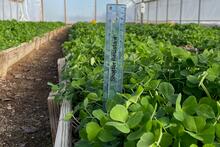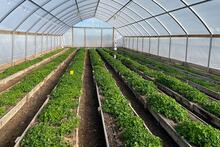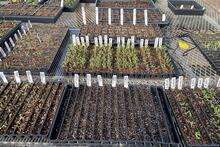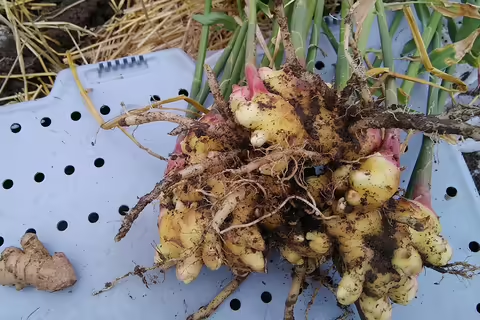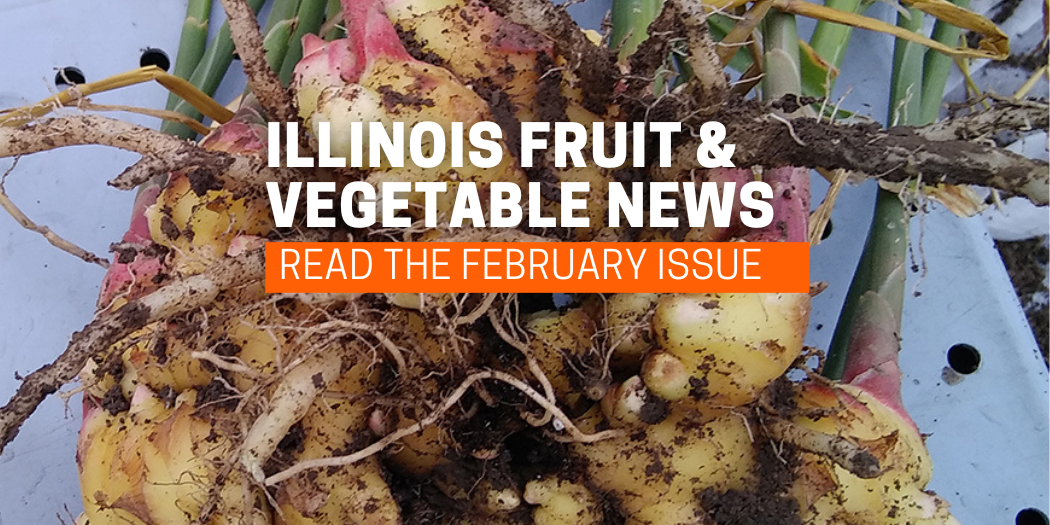
Two New Webinar Series Offered
I am happy to announce that the Beginning Apple Grower Webinar Series and High Tunnel Berry Production Webinar Series began February 9 and continues each Thursday. Details and registration information is available. This series is brought to you by the University of Minnesota, University of Wisconsin, Iowa State University, and University of Illinois.
Kacie Athey: 217-244-9916; kathey@illinois.edu
Food Safety Certification for Specialty Crops Program
The Food Safety Certification for Specialty Crops Program provides assistance to specialty crop operations that incurred eligible on-farm food safety program expenses is open for the 2023 program year. The application deadline for the 2023 program year is January 31, 2024. Don’t miss out. Visit your local USDA-FSA Service Center to discuss your eligibility and submit an application.
Elizabeth Wahle: 618-344-4230; wahle@illinois.edu
Agritourism Liability Insurance Tax Credit Application
The Agritourism Liability Insurance Tax Credit Application is available through the Illinois Department of Agriculture. For taxable years beginning on or after January 1, 2022, and ending on or before December 31, 2023, any individual or entity that operates an agritourism operation in the State during the taxable year shall be entitled to a tax credit against the tax imposed by subsections (a) and (b) of Section 201 equal to the lesser of 100% of the liability insurance premiums paid by that individual or entity during the taxable year or $1,000.
Once you fill out the application, IDOA will verify your eligibility, then issue a tax credit certificate that you will attach to your tax return. You must have this certificate to claim the tax credit. You will need to apply separately for 2022 and 2023. I’ve talked to growers who have already applied, and they tell me the process is easy. The deadline for applying for 2022 Tax Year is February 28, 2023, so don’t delay.
Elizabeth Wahle: 618-344-4230; wahle@illinois.edu
Northern Illinois Regional Report
The Stateline Fruit and Vegetable Growers Conference was held February 6 at NIU Rockford. In it’s 27th year, Sarah Farley and I host this program every year for our Northern Illinois and Southern Wisconsin specialty growers. We were pleased to be joined by Emily Lavely, Michigan State University tree fruit educator, who delivered a keynote on roots and a breakout on rootstock pruning.
This event also included University of Wisconsin-Madison Extension vegetable educator Sam Oschwald-Tilton who gave an overview on weed management strategies for vegetable production.
Additional sessions in our fruit and vegetable tracks were provided by University of Illinois Extension specialists, Mohammad Babadoost and Kacie Athey, and educators, Zack Grant and Grant McCarty.
Nearly 75 specialty growers from Northern Illinois and Southern Wisconsin joined us this year with almost a one-third of these growers new to this program and close to 40% from Southern Wisconsin. With positive feedback and suggestions, Sarah and I look forward to our 2024 program.
Grant McCarty: 815-235-4125; gmccarty@illinois.edu
Sarah Farley: 847-223-8627; sfarley@illinois.edu
West Central Illinois Regional Report
Western Illinois has seen a fairly mild and muddy winter thus far. Though it is late February, we all know winter is not over even as we used extended forecasts to peer around the corner. As of now, forecasts are showing more of the same. Highs have been dancing between the 40s and 50s with lows still getting cold enough to have us scraping our windshields in the morning. Weather history can give an accurate glimpse of past patterns, but so do my energy bills. Traditionally, my energy bills have been highest in February, showing this is often the coldest month of winter. I would wager this month’s bill will be lower than previous years.
I have been monitoring the chilling hours using MRCC’s Vegetation Impact Program hosted by Purdue. Early in winter all of Illinois was well ahead of the typical chilling hours. As the winter has progressed portions of the state, notably southern and western Illinois are experiencing fewer and fewer chilling hours. We are all still ahead of the curve, especially in northeastern Illinois.
Currently, many growers are in full swing into seed starting with cool-season crops. Newly seeded flats of warm-season crops are probably sliding under the grow lights as I type. It is fairly common for us to start seeds a little too early in the season. Perhaps the optimist in us. But if weather patterns hold, it may work out. Are you banking on the mild weather holding and getting those transplants out earlier than normal? In the woods and orchard, maple syrup is being tapped and fruit trees are getting pruned. The 2023 growing season has arrived!
Chris Enroth: 309-837-3939; cenroth@illinois.edu
St. Louis Metro East Regional Report
Red maples are in bloom in the St Louis Metro East, signifying the beginning of the coming Spring warm-up. Soil temperatures at 4” (bare soil) are climbing into the low 50s during the day and back down to the upper 30s to low 40s at night.
The peach crop is still being assessed but most reports coming in suggest the majority of the Illinois peach crop will be significantly reduced. It’s not all bad news; some reports include cultivars and locations (as of today) still carrying enough crop to justify a full spray program. No signs of field prep yet, but pruning of apples, peaches, and grapes is ongoing. Standing water can be seen in low areas after recent rains, but nothing approaching flood levels.
Elizabeth Wahle: 618-344-4230; wahle@illinois.edu
Southwestern Illinois at Waterloo Regional Report
I think it is still supposed to be winter on the calendar, but we have been more spring-like lately than anything. Temperatures have been generally at or above average with most days in the 40s to 50s for highs and a few days near 70°F. We have had a decent amount of precipitation with 0.85” the first, full week of February, and another 1” the second week and are forecasted to have rain the middle of this week. Things have started to dry a little prior to this forecasted rain to do any frost seeding or get out across fields with better drainage, but not much if any spring tillage done yet.
With decent weather, it will be time to plant some spring crops soon like lettuce, spinach, carrots, and peas out in the field. In the greenhouse, transplants are getting started for cool season and early crops. High tunnel crops have been doing well and have been rebounding or replanted since the severe cold the end of 2022. Cover crops that usually are rather browned and dormant this time of year still are green and getting ready to take off if the weather continues to be favorable. Not a lot of vertical growth, but lots of branching and tillering of grains and clovers that will lead to more prominent biomass.
Hopefully, seeds and plans for the season are starting to come together and now we will just have to see what Mother Nature provides. Current conditions and forecast make it seem like spring is right around the corner, but I can’t help but feel that winter isn’t completely done with us quite yet!
Nathan Johanning: 618-939-3434; njohann@illinois.edu
Dixon Spring Ag Center Regional Report
The last few days have definitely felt like spring, with high temperatures ranging in the upper 50s to mid 60s. But every fifth or sixth day, the temperature dips low enough to remind us that it is still February and to not put away our winter clothes just yet.
As a reminder to growers with plasticulture strawberries that have removed or plan to pull off the row cover, be sure to scout for aphids and any other insect pests that may have been happily overwintering underneath the warm blanket. Be mindful that keeping the row cover on to long into the season can create blooms really early in the season, extending the time that you need to worry about frost protection.
The clover cover crop is happily growing within the high tunnel, with an average height of about 7 inches. No signs of flowering have been noted yet. Yellow sticky traps are still being replaced weekly to monitor insects within the tunnel and data loggers have been installed both inside and outside of the high tunnel monitoring air temperature, relative humidity, dew point, soil temperature (inside tunnel only), and solar radiation.
Residue from the spring oats that winter killed in December can still be seen on the top of the beds as well as the drip irrigation lines used to irrigate the cover crop as needed since seeding. As this is the first year we have worked with cover crops in our high tunnel, we have several factors to consider as we are deciding on the right time and strategy for terminating the cover crop. For this research study, our focus is to create a habitat for overwintering insects not maximizing biomass.
Tomatoes, peppers and one row of cut flowers will be planted into these beds between April 1 and April 15. We need the clover to be in the flower stage to achieve successful termination, which we plan to accomplish through mowing. We will not be using herbicide or solarization. Hopefully, the clover will be flowering a couple of weeks before planting, allowing time to terminate and then start to breakdown prior to transplanting.
We will be keeping the tunnel closed up as much as possible to force the clover into flowering earlier than what is typical in a field setting. Stay tuned for next month’s issue to monitor our progress.
Growing Ginger in Illinois
These past few months I’ve been traveling around the state presenting on the ginger study done in 2022 funded by a USDA Specialty Crop Block Grant. For the study, we wanted to compare ginger grown in a high tunnel (under plastic all year) against ginger grown in a caterpillar tunnel (30% shade cloth during the spring and summer and plastic in the fall). More on the results of that study are below.
After the presentations, I’ve had some great conversations with growers and other educators about this unique tropical crop. Here is a list of Frequently Asked Questions I have somewhat managed to remember.
Can you sell it?
Probably the most common question after a prolonged stare to gauge my sanity. Yes, you can sell ginger here in Illinois. The first time I heard about growing ginger in the northern half of the United States, was a presentation by Judson Reid from Cornell in 2016. He remarked their farmers sell fresh ginger for $20 a pound in New York. At that time, it elicited an eye roll. Sure in New York, but what about rural Illinois? My curiosity was still activated on this crop, so we worked with some farm partners in the following years to grow and sell ginger. And Judson was wrong, we did not sell it for $20 a pound, we sold it for $24 a pound. $1.50 an ounce to be exact.
Can you really grow ginger in Illinois?
Yes, you can. But season extension and presprouting indoors are critical components. In the tropics, ginger has an 11-month growing season. We can’t match that in Illinois, but we can still get good yields if we presprout as early as possible in the winter (February). Warm up our soils in the spring for planting with high tunnels, caterpillar tunnels, low tunnels, or combinations of those. And extend that season into the fall with those same season extension structures.
Ginger sounds like a high-value crop I can use in my high tunnel rotation. Will it help break disease cycles?
Maybe. At first, I thought ginger being such a separate plant family from the number one high tunnel crop, tomatoes, would mean this could help in a rotation. Unfortunately, that is not true with a soil-borne bacterial wilt (Ralstonia solanacearum), a troublesome disease of tomatoes, and a devastating disease of ginger. But the story does not end there because bacterial wilt has different races. Specifically:
- Ginger bacterial wilt = Ralstonia solanacearum race 4
- Bacterial wilt of tomatoes and peppers = Ralstonia solanacearum race 1
When it comes to plant disease, I am not a plant pathologist. But I did check with our University of Illinois Plant Clinic and they have yet to encounter R. solanacearum race 4 in Illinois. Diving into the literature out of Hawaii we note the following:
The strain of the bacteria attacking ginger will weakly attack tomato, pepper, and eggplant (3, 5). Although laboratory tests have shown that the strain that causes severe tomato wilt does not attack ginger, a relationship between the strains of the bacteria does exist. Although relationships may be of little importance to the grower, there is a possibility that under field conditions, the tomato strain could be severe on ginger and the ginger strain severe on crops belonging to the tomato family. Thus, it is highly undesirable to plant either crop in a field in which the other had been diseased.” –Hawaii Extension
Turns out R. solanacearum has a massive range of hosts, but there may be a saving grace that race 4 seems to target ginger and race 1 targets tomatoes. The research that I can find on this topic is fairly dated and geared mostly toward a tropical environment. This issue should be studied more by a plant pathologist with Midwest growing in mind.
Can I use grocery store ginger as my seed pieces?
It is not recommended to use grocery store ginger. Mostly for the disease mentioned in the previous question, bacterial wilt of ginger. It is best to use certified disease-free ginger seed pieces (rhizomes). There is no way to guarantee a ginger rhizome sitting in the grocery bin is disease-free. And ginger bacterial wilt can survive for 40 years in the soil.1 This means it would be pertinent to take extra steps to avoid this disease. Grocery store ginger is treated for cooking, not growing, and may be sprayed with sprouting inhibitors.
What do you sell? And does locally grown ginger look like the stuff in the grocery store?
Most commonly the harvested portion of ginger used is the rhizome. Though the leaves can also be used for cooking, making teas, or distilling oils. A rhizome is a modified underground stem. The rhizome is planted underground and has buds where the leaves emerge. Ginger is propagated via the division of the rhizome. These divisions are term seed pieces or “mothers.”
The ginger found at American grocery stores is typically grown in India, sold to China, and exported to the United States. Grocery store ginger has gone through a nearly 11-month growing season and is known as mature ginger. Mature ginger has a thick outer cuticle (skin) and a fibrous or stringy interior. Mature ginger, ships well and has a shelf life of 1 to 3 months depending on storage methods.
Illinois growers do not have an 11-month window to grow ginger. Therefore, with the shortened development timeframe, we will be harvesting immature ginger or “baby” ginger. Immature ginger has not developed a skin and is less fibrous. Arguably, it is thought to have a higher quality flavor than mature ginger. Immature ginger has a much shorter shelf life of two to four weeks. Fortunately, it can be placed in the freezer and stored for several months when cooking.
Is shade necessary for ginger in the summer?
Over the years of growing ginger in a high tunnel, we would often encounter sunburn on the leaves, even with proper hardening off. According to Hawaii Extension, “Young ginger plants are very susceptible to sunburn when screen temperatures exceed 90°F. (Sunburn is not due to high temperatures but to high light intensity.)” This light/heat stress seemed to be present through July, and by August the plants would start to put on healthy, vigorous growth. Yet, growing ginger in my yard under the shade of a magnolia grew deep green, plentiful leaves without signs of stress even at the beginning of summer. So, what if we tried shade cloth with a season extension device? Would we reduce stress and increase yield?
Partnering with Dr. Shelby Henning at Western Illinois University, we sought to examine the benefits of early-season shade for ginger. Our trial involved growing ginger in a traditional high tunnel (plastic all season but vented) versus a caterpillar tunnel with 30% shade cloth early and mid-season and plastic in the fall. Our trial sites included Murphysboro, Jacksonville, Quincy, Macomb, and Galesburg. In summary, we did not see an improved yield with the caterpillar tunnels (shade cloth treatment). Only the Jacksonville caterpillar tunnel yielded more than what we harvested from the high tunnels.
One reason we think the caterpillar tunnels did not perform as well as the high tunnels are that each one was installed on brand-new, (usually turf) ground. Meanwhile, the high tunnels have all been in operation for several years, with a good amount of soil and weed management under their belts. Examining ginger grown under early season shade is worth exploring more.
We have more resources for growing ginger. Check out our recent podcast where we dive into the details of growing ginger, galangal, and turmeric in Illinois.
Growing ginger, turmeric, and galangal in Illinois, Part 1 – Getting to know these spices, how they are used, sourcing seed pieces, and presprouting.
Growing ginger, turmeric, and galangal in Illinois, Part 2 – Planting, culture over the growing season, harvest, and processing
Finally, we want to hear from you the grower and consumer. Following is a VERY short survey to gauge grower interest to produce these tropical spices and consumer interest in using these tropical spices. Help us out by taking this quick survey at go.illinois.edu/ginger.
1 Source Handbook of Plant Disease Identification and Management. 11.2.1 – R. solanacearum hibernates in the host plant in winters. However, the bacterial population ceases to minimal at this time; the pathogen can still survive for over 40 years in cold conditions.
Chris Enroth: 309-837-3939; cenroth@illinois.edu
Upcoming Events
Southern Illinois Summer Twilight Series | 3rd Monday Evening in May-August.
ISHS Summer Hort Field Day | Thursday June 8, 2023 at Curtis Orchard, Champaign.
Less Seriously
Not really sure what brought on the rapid fire, corny “dad” jokes and thoughts from my 12-year old this past week but he was definitely full of them. Couldn’t keep these gems to myself so enjoy 😉
Why should you knock on the refrigerator door before opening? There may be salad dressing.
If one teacher isn’t expected to teach all subjects, why is one student expected to learn all subjects?
Since tomatoes are technically a fruit, would you consider ketchup a smoothie?
Are oranges named oranges because oranges are orange, or is orange named orange because oranges are orange?
What happens if you press the accelerator and the brake at the same in the truck? Does it take a screen shot?
Hey mom, the oldest picture of you is also the youngest picture of you.
Why are deliveries made on a ship called cargo but deliveries made from a car are called a shipment?
University of Illinois Extension Fruit and Vegetable Specialists
Extension Educators – Local Food Systems and Small Farms
- Bronwyn Aly: Gallatin, Hamilton, Hardin, Pope, Saline, and White Counties | 618-695-2441 | baly@illinois.edu
- Katie Bell: Franklin, Jackson, Perry, Randolph, and Williamson Counties | 618-687-1727 | klbell@illinois.edu
- Sarah Farley: Lake and McHenry Counties | 847-223-8627 | sfarley@illinois.edu
- Nick Frillman: Woodford, Livingston, and McLean Counties | 309-663-8306 | frillma2@illinois.edu
- Zachary Grant: Cook County | 708-679-6889 | zgrant2@illinois.edu
- Doug Gucker: DeWitt, Macon, and Piatt Counties | 217-877-6042 | dgucker@illinois.edu
- Grant McCarty: Jo Daviess, Stephenson, and Winnebago Counties | 815-235-4125 | gmccarty@illinois.edu
- Kathryn Pereira: Cook County | 773-233-2900 | kpereira@illinois.edu
Extension Educators – Horticulture
- Chris Enroth: Henderson, Knox, McDonough, and Warren Counties | 309-837-3939 | cenroth@illinois.edu
- Andrew Holsinger: Christian, Jersey, Macoupin, and Montgomery Counties | 217-532-3941 | aholsing@illinois.edu
Extension Educators – Commercial Agriculture
- Elizabeth Wahle: Fruit and Vegetable Production | 618-344-4230 | wahle@illinois.edu
- Nathan Johanning: Madison, Monroe, and St. Clair Counties | 618-939-3434 | njohann@illinois.edu
Campus-based Extension Specialists
- Kacie Athey: Entomology | 217-244-9916 | kathey@illinois.edu
- Mohammad Babadoost: Plant Pathology | 217-333-1523 | babadoos@illinois.edu
The Illinois Fruit and Vegetable News is a production of University of Illinois Extension and provides timely, research-based information that commercial fruit & vegetable growers can apply to benefit their farming operations.
Address any questions or comments regarding this newsletter to the individual authors listed after each article or to its editors, Nathan Johanning, 618-939-3434, njohann@illinois.edu or Bronwyn Aly 618-695-2441, baly@illinois.edu.
To receive or be removed from email notification of new postings of this newsletter, contact Nathan Johanning or Bronwyn Aly.
Download this issue
Download this issue and share with others.

